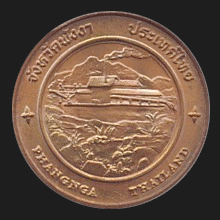|
Phang Nga (พังงา)
Thai. Name of a river, a provincial capital, as well as of
a province on the west coast of the South Thai peninsula
along the Andaman Sea
(map). The city has a population of approximately 9,000 inhabitants and is situated at about 90 kms from
Phuket and 788 kms from
Bangkok. The area is well-known for the extraction of tin and often dredgers
(fig.) can be seen at work.
Phang Nga was originally inhabited by small communities and named Ban Kraphu Nga
(บ้านกระพูงา).
During the reign of King
Rama II, nearby areas, including
Thalang (now
Phuket),
were invaded by the Burmese and consequently many people fled to Ban Kraphu Nga.
In 1824, Siamese troops expelled the Burmese invaders and the newly crowned King
Rama III renamed the area Phang Nga,
which in 1933 was declared a province. There are many
places of interest in the Bay of Phang Nga
area (map
-
fig.) in the South of the province, which is known for its
stunning limestone rock formations, some with caves and a few with pre-historic paintings,
such as the Khao Khian (เขาเขียน) tunnel cave (map
-
fig.),
as well as a labyrinth of waterways through dense
mangrove forests. On the island of Koh Panyi live Islamic
sea gypsies on pile dwellings built in a bay against the face of a sheer cliff (map
-
fig.). Also renowned is Koh Tah Puh,
i.e. ‘Nail
[Rock] Island’
or ‘Crab
Eye Island’, with its long landing-stage built in sea (fig.). It is part of Ahw Phang Nga National Marine Park and after a scene of a 007-movie was filmed here, it is nicknamed James Bond Island (map
- fig.). Off the west coast lie the Similan Islands. This province and especially the beach resort town of Khao Lak, was among the hardest hit when a
tsunami hit Thailand's Andaman coast line on 26 December 2004, killing around eight thousand people with the majority of deaths in this province, many of them foreign holidaymakers celebrating Christmas. Worldwide over 220,000 were killed or went missing. The province has eight
amphur.
The name Phang Nga can be translated as
‘tusk or ivory
(nga) of a female elephant (phang)’,
as well as ‘broken (phang)
tusk (nga)’.
See also
Phang Nga data file,
THEMATIC STREET LIGHTS (1)
and
(2),
POSTAGE STAMPS,
WATCH VIDEO (1),
(2),
(3)
and
(4), and
VIDEO (E1)
and
(E2).
回






|

